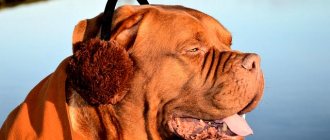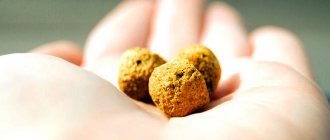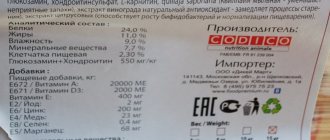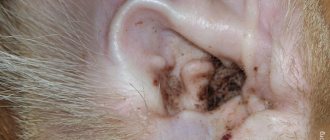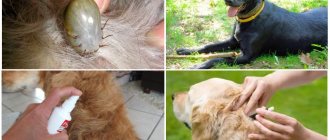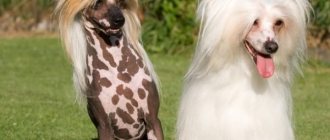Healthy joints are the key to an active and happy life for your pet. Pathologies of the musculoskeletal system lead to lameness, pain and limited movement. Joint diseases occur in a wide variety of dogs, regardless of breed and age.
Their appearance is promoted by several common factors: mechanical damage (injuries, bruises), genetic predisposition, improper diet (lack of vitamins and microelements), etc.
Therefore, the slightest signs of joint damage are a reason to contact a veterinarian. After all, timely treatment increases the chances of recovery, while severe forms of disease (in an advanced stage) require more serious and lengthy measures, and in some cases, surgical intervention.
In puppies
Puppies are most often susceptible to the following joint diseases:
- Hip dysplasia (in puppyhood the pathology practically does not manifest itself, but only develops rapidly, becoming apparent at a more mature age - by about 1.5 years).
- Osteochondrosis (develops in large breed puppies).
- Metabolic (dystrophic) arthritis - most often occurs in fast-growing puppies due to metabolic disorders in the body.
Diagnosis of arthritis in dogs
Making a diagnosis is always a complex undertaking, requiring several examinations and laboratory tests.
Table 1. Diagnostic procedures to confirm arthritis in dogs.
| Procedure | Peculiarities |
| In-person examination by a veterinarian |
|
| X-ray |
|
| CT scan |
|
| Laboratory research |
|
| Histology and cytology |
|
In large and small breeds
Oddly enough, there is a clear pattern between the breed of the dog (its size and weight) and this or that joint disease. For example:
- In large breeds of dogs (working shepherd dogs, Alabais, Labradors, Great Danes, etc.), pathologies such as dysplasia and arthrosis are most often found. This happens as a result of intense physical activity (for example, in fighting dogs) and the impact of large body weight on the musculoskeletal system.
- In small breeds (dwarf poodle, chihuahua, Yorkshire terrier, etc.), the most common cases are osteochondrosis and atlantoaxial instability (a congenital disease characterized by instability of the first cervical vertebra in relation to the second).
Important! In addition to dwarf breeds, other dog breeds are also susceptible to osteochondrosis, for example, Labradors, Chow Chows, Basset Hounds, Rottweilers, Dobermans, St. Bernards, etc.
Treatment methods
The choice of treatment is based on the form of the disease and the severity of its course. The capabilities and opinions of the owners are also taken into account. Acute septic and other forms are usually treated conservatively. Pathologies with destructive changes are rarely amenable to drug treatment. Owners should be explained the need to control nutrition - reducing the calorie content of food in order to reduce the weight of the animal. Limiting movement will reduce re-injury to joints.
The use of non-steroidal anti-inflammatory drugs allows you to block the synthesis of prostaglandins. The use of oral anti-inflammatory drugs can lead to gastrointestinal ulcers. For treatment use:
- phenylbutazone;
- ketophene;
- Rimadyl.
There is good activity of the drug Adequan. Injections are given once every 3-5 days, the total course of treatment is 8-10 injections. The drug inhibits the action of metabolites, enzymes and prostaglandins. There is also an improvement in the growth of cartilage cells and fibers. Corticosteroids have a better anti-inflammatory response, but they reduce the healing effect, so damaged cartilage will take a long time to recover, which is fraught with relapses.
Puncture method of treatment:
- makes a puncture in the joint capsule with a thick needle;
- pathological contents (purulent exudate) are removed;
- the cavity is washed with antiseptic solutions;
- antibiotics are injected into the joint.
Brucellosis arthritis in dogs requires long-term treatment with antibiotics. A course of at least 1.5 months is prescribed. Doxycyline and trimoxazole are used. It is necessary to supplement therapy with sulfonamide drugs.
Punctures and washing of the articular cavity are repeated until the pathological exudate is completely eliminated. During the treatment period, limb mobility should be limited with bandages and splints. This method is not always effective, since it is not possible to adequately rinse the joint cavity and evacuate the contents in the presence of pockets. In addition, dead tissue cannot be removed, which aggravates the pathological process, prolonging recovery.
Surgical intervention is necessary for changes in cartilage and bone tissue. It is possible to quickly eliminate the separation of the coronoid process and osteochondrosis. Surgery is especially effective in small breeds of dogs - complications are often observed in large animals with dysplasia. If the hip joint is affected, it is recommended to install an implant; if it does not take root, then resection of the head is performed.
Arthrotomy is accompanied by opening of the joint capsule and revision of the affected organ. Purulent contents and dead tissue are removed and sanitized with antiseptic solutions. If articular ends and bones are involved in the pathology, resection of the processes is performed. Operations for installing artificial implants have been developed. Arthrotomy is accompanied by extensive wounds and prolonged healing. Methods for revision of arthritis in dogs using endoscopes are now being actively developed. The operation is performed through small incisions and is largely devoid of the disadvantages of traditional surgery and puncture.
For arthroscopic treatment, an incision of up to 2.5-3 mm is made to insert an endoscope, and several functional holes are made for inserting surgical instruments. This method allows you to remove not only exudate, but also dead tissue, as well as assess the condition of rubbing surfaces, cartilage, and bones. The method does not cause major damage to the dog’s limb, which speeds up recovery.
Prevention
To avoid serious pathologies of the joints, it is necessary to follow the following recommendations from early puppyhood:
- Avoid too intense physical activity and at the same time avoid physical inactivity.
- Regularly undergo preventive examinations.
- Carry out X-ray examination (both in early and adulthood).
- Monitor the animal’s diet so that the food is as rich in vitamins and minerals as possible (without overeating).
- Avoid overcooling your pet.
- Avoid injuries and injuries (including fights with other dogs). And, if necessary, promptly disinfect affected tissues.
Probability of relapse
The postoperative prognosis is positive in 90% of cases.
The animal regains normal motor function within 3 months after surgery. The result depends on the severity and neglect of the disease and the physiotherapeutic measures taken.
The likelihood of relapse is low. Repeated dislocation can only occur in dogs with a genetic predisposition to joint diseases.
It is important to have the breeders checked by a veterinarian. To do this, a patella luxation test is performed.
Animals predisposed to pathology and carriers of this gene are not allowed for breeding. Puppies with congenital joint disease are euthanized at an early age.
Injuries
There are the following types of injuries:
- wounds;
- sprains;
- dislocations.
Wounds
Incised wounds are covered with scab and heal well if the conditionally pathogenic microflora does not penetrate into the joint. The animal needs rest. If the defect is extensive, stitches are applied. Protect the wound from secondary infection. When suppuration develops, antibiotic therapy is used locally, in the form of powders.
Puncture wounds are more difficult to treat. Their consequence is purulent arthritis if the pathogenic microflora enters anaerobic conditions.
Sprains
Distortion (stretching) occurs during sudden jumps, pinching, or being hit by a car. The following symptoms appear the next day:
- lameness;
- soreness;
- the joint is swollen, painful;
- the dog does not lean on its paw, holds it in a half-bent position;
Treatment: a tight bandage is applied and hydrocortisone is injected intramuscularly.
Lameness
Dislocations
The following types of dislocations are distinguished:
- complete, bones completely lose contact;
- subluxation, contact preserved;
- simple, the skin is not damaged;
- open, joint bones exposed;
- congenital, affects mainly puppies;
- familiar.
The pathology is characterized by limited and painful movements. Treatment consists of reduction with local or systemic anesthesia. A bandage is applied that restricts movement for 10–14 days.
Arthritis
The inflammatory process occurs mainly in old animals. The disease affects massive dogs and spares small dogs. The interosseous joints become painful, and the dog is afraid to move.
The following causes of joint inflammation are identified:
- Functional overload.
- Obesity.
- Genetic predisposition.
The following types of arthritis are distinguished:
- purulent - occurs if the infection gets inside the joint capsule;
- rheumatoid – an autoimmune pathology in which the body perceives its own connective tissue cells as pathogens;
- deforming, is a consequence of constant microtraumas. The bones are deformed, the animal lame;
- dysplasia is a congenital disease of the hip joints. Corrected surgically, the dog is excluded from breeding.
Causes of arthritis in dogs
At the place where the bones “connect” with each other, there is an articular capsule, and the “layer” between them is cartilage. This is a kind of cushion that prevents the articular surfaces of the bones from being abraded during movement, deformed and destroyed.
Inside the capsule there is a liquid that allows the joint to perform its function unhindered, without pain. But why can an inflammatory process develop in a joint?
- Weakened immunity. Any infection that enters the animal’s body provokes the development of an inflammatory process.
- Injuries: dislocations, bruises, sprains and torn ligaments, fractures. A dog can trip or twist a paw while running or jumping (kids, old people and overweight dogs are especially susceptible to such falls).
- Rest on a hard and cold floor. If a dog lies on a hard surface for a long time, the joints often swell and harden, and arthritis and arthrosis may develop.
- Constant stress.
- Poor nutrition. This is not the main reason, but rather a contributing one.
Now let's look at the causes of arthritis in dogs - of course, they are closely intertwined with species.
Causes of rheumatoid arthritis
If we talk about rheumatoid arthritis in dogs, the cause of its occurrence has not yet been discovered. Fortunately, they don’t get sick with it very often.
And small dogs (dwarf, miniature) are most susceptible to this autoimmune disease. Moreover, they are only about 4 years old.
That is, it is not old people who suffer, but even young dogs. In addition, not one joint is affected, but several at once.
After all, antibodies are carried through the bloodstream throughout the body, as a result of which almost all cartilage tissue is destroyed.
Injury
One of the reasons a dog develops arthritis is trauma. Yes, the dog can hit hard, which will lead to disruption of the integrity of the joint capsule.
Because of this, swelling develops. And if a bacterial infection also “attaches”, then the dog develops arthritis.
However, traumatic functional arthritis in dogs can occur. In this case, when a bruise occurs, the capsule remains intact, but the muscles suffer (as with sprained ligaments and muscle fibers).
In this case, a cavity is formed in which blood begins to accumulate (a hematoma or simply a bruise), and edematous fluid. Over time, everything is restored, and the arthritis goes away on its own.
Other reasons
Treatment
The therapeutic strategy is aimed at relieving pain and restoring cartilage tissue. They use medication or surgery, diet, and physical therapy.
Types of joints
Arthrosis
Arthrosis is the result of long-term permanent dystrophic changes in which the interosseous lining is destroyed. The following stages of arthrosis are distinguished:
- Diagnosed only by x-ray.
- The dog often changes its supporting paw. A crunching sound is heard in the joint. Lameness develops, which manifests itself during active movement.
- The joint is deformed. The paw moves to the side, pain is felt.
The disease is incurable. Surgical intervention is indicated for puppies. The animal will feel satisfactory when performing restrictive measures.
Synovitis
Another name is bursitis. Acute synovitis occurs as a result of a bruise. Based on the nature of the exudate, serous or fibrinous inflammation is distinguished. The dog's initial condition is satisfactory. Tumors of a pasty consistency develop over the joint. Local temperatures are rising. When pressed, the dog whines.
Bursitis
With a long course of the disease, the tumor opens, a fistula forms, and purulent inflammation occurs. Treatment of the disease must be entrusted to a specialist, otherwise the dog risks becoming disabled.
Genetic abnormalities of the musculoskeletal system of dogs
By crossing breeds and modifying them, dog handlers developed new breeds of dogs used in a specific situation. For example, the dachshund was created to hunt badgers and has the ability to easily penetrate their burrows. But this is one side of the breed's abilities.
The second is the risk of developing a disease characteristic of dogs with a long spine - displacement of the intervertebral discs with further weakening of the hind legs.
So, hereditary pathologies of the musculoskeletal system include:
- hip dysplasia;
- Lagg-Calv-Perthes disease;
- osteochondrosis;
- displacement of intervertebral discs;
- deformation of the cervical vertebrae;
- elbow dysplasia;
- displacement of the head of the radius.
A common deviation is hip dysplasia, or the discrepancy between the cup of the hip joint and its head and the incorrect insertion of the neck of the femur.
Hip disorder was first studied in German Shepherds with a diagnosis described in 1935. Based on the existing picture of the disease, dysplasia was identified in almost all large breed dogs. These are Great Danes, Bulldogs, Chow Chows, Boxers, Rottweilers, Labradors, St. Bernards, and Newfoundlands. Greyhounds and, to a lesser extent, small breed dogs are not predisposed to this disease.
Symptoms of the pathology include: rapid fatigue, gait disturbances, and difficulty walking up stairs. If you do not pay attention to the first signs of the disease and neglect to contact a veterinary clinic, then in the future your pet may develop lameness and even complete loss of mobility.
Lagg-Calv-Perthes disease occurs in small breed dogs: Pekingese, French bulldogs, schnauzers, toy poodles, Spitz. The pathology is a disruption of the blood supply to the femoral head and leads to necrosis of the femur.
The first symptoms are barely noticeable: mild pain in the joint, slight limping, dragging of the paw. Any deviation in the animal’s behavior should be a reason for urgent contact with a veterinary clinic.
Osteochondrosis in dogs is associated with damage to the cartilage of the intervertebral discs. The degree of inheritance is quite high and exceeds 50 percent. Breeds of large, fast-growing dogs at risk: Rottweilers, Newfoundlands, St. Bernards, Bernese Mountain Dogs, Labradors.
Displacement of intervertebral discs occurs both in breeds prone to this disease (Dachshund, Pekingese) and in older dogs of large breeds (Labrador, German Shepherd). The animal may experience pain or unsteadiness of gait, the hind legs do not obey or are paralyzed.
To diagnose the disease, it is necessary to conduct an examination at a veterinary clinic. As a rule, this is a magnetic resonance or computed tomography scan that detects damage to the spinal cord and intervertebral disc.
Deformation of the cervical vertebrae is typical for breeds with a narrow vertebral line: chow chows, Dobermans, small breeds. The characteristic pain associated with the disease is pain in the neck, in which the dog holds its head in an unnatural position with a downward tilt.
Coordination of movements may also be impaired in animals. Help in these circumstances will be a neurological examination in a veterinary clinic using modern diagnostic methods: computed or magnetic resonance imaging, myelography.
Elbow dysplasia is a physical deficiency in the formation of the elbow joint and surrounding tissues. The following breeds are at risk: German Shepherds, Rottweilers, Bloodhounds, Mastino-Neapolitans, Golden Retrievers, St. Bernards, Bernese Mountain Dogs.
Symptoms include lameness and pain when bending the paw. If you consult a veterinarian in a timely manner, the disease is curable, often requiring surgical intervention.
Congenital displacement of the head of the radial bone (dislocation of the elbow) occurs due to a genetic defect and is typical for dogs of small breeds: Yorkshire terrier, Pekingese. A sign of an abnormality is lameness or an unnatural gait of the pet with tucking its paw.
An accurate diagnosis with an x-ray examination of the pet in a veterinary clinic will determine the diagnosis and help the animal overcome the disease. Otherwise, if the disease is advanced, the dog may lose mobility.
Symptoms of joint diseases and their treatment in dogs
Joint diseases in dogs are not such a rare occurrence. This is usually a consequence of the aging of the animal's body. The truth is that such a pathology occurs due to certain reasons and ailments. Be that as it may, such a disease is always difficult to cure.
Animal owners need to know that with proper therapy and constant monitoring, most joint diseases can be treated symptomatically, which allows the animal to live a peaceful life. To avoid any problems, it is important to immediately seek veterinary help in this case. After all, treatment started on time always provides an opportunity for recovery.
Signs and types of joint diseases in dogs
For successful treatment of any ailment, it is important to know its symptoms. Treatment of joint diseases largely depends on its recognition. Therefore, you need to know the main signs of the disease:
- lameness;
- pain, improper mobility, swelling of the joints;
- amyotrophy.
Any of these signs is a reason to seek veterinary help, X-ray or other studies. After all, these symptoms can indicate many things:
- injury - in this case, an immediate disruption of the mobile function of the joints occurs, acute pain, swelling, and an inflammatory process occur;
- the genetic nature of their lesions is the hereditary transmission of canine diseases. Therefore, animals with such a defect are usually castrated so that they do not endow their offspring with such a defect. It can appear in puppies even after a certain number of years);
- metabolic failures - this is what can cause destructive joint pathologies;
- exposure to an infectious lesion - bacteria or microorganisms, once in the blood, cause pain, swelling of the joints, increase the temperature, and the number of leukocytes;
- the result of malfunctions in the pet’s immune system, resulting in inflammation and erosive effects on bone joints; articular oncological pathologies, which is observed in old dogs.
Factors and reasons
Joint diseases and their treatment are the most common reason for visits to the veterinary clinic by dog lovers. After all, such failures negatively affect the life of pets, worsening its quality. Of course, there are reasons for this condition. However, there are generalizing factors of the pathology in question.
For example, dogs are highly active animals. They constantly cannot sit still, they often get into fights, which often ends in injury. The hereditary predisposition to this condition of individual breeds also plays a significant role here.
Often the cause of joint disease in pets is the owners themselves, who do not properly care for them. It is errors in feeding them, a lack of vitamins and nutrients in the diet that can lead to this condition. Among the causes of painful joint damage are:
Aging - with age, an animal’s joints function worse and worse, and their cartilage layer gradually wears out. Which leads not to slipping, but to friction of the bones, which, quite understandably, causes inflammation and pain.
Arthritis - usually occurs against the background of joint injury or age-related damage (osteoarthritis). An animal with such a pathology suffers from severe pain at the slightest movement, so it moves only when necessary. He almost doesn’t want to go out for a walk, and from constant lying down he gets fat, which also has a bad effect on his health.
Destruction of the hip part of the skeleton is a genetic ailment that is characteristic mainly of large breed dogs (shepherd dogs, retrievers, Labradors, etc.). Among the reasons for the occurrence of the disease are poor heredity, improper feeding, leading to obesity of the animal.
Moreover, a similar condition can occur at the age of 1-1.5 years, and the growth of the body will only aggravate the situation if therapy is not started in time. Dogs in this position have difficulty standing up, limp when walking, and touching their thigh is accompanied by severe pain.
Arthrosis is a chronic disease that represents arthritis in an advanced form and is characterized by two forms: primary and secondary. The first is the result of the aging of the dog’s body, and the second is a consequence of erosion, changes in the cartilage layer, untreated arthritis and calcium deposits on the joints.
In addition, such a pathology can be caused by forgotten injuries, excess weight, physical exertion that is too much for the animal, and disruptions in blood circulation. The symptoms of the disease completely coincide with those of arthritis: pain, swelling, immobility, lameness. Neglect of the disease leads to joint deformation; X-GIA is treated for dogs;
Osteochondrosis is a disease based on the destruction of cartilage, which makes itself felt by gradual changes in the pet’s behavior. At first he does not want to get up every time, and if he does this, then with increasing caution.
Further, the pain will progress, and the joints themselves will increase in size. The dog practically stops moving and even changing position.
Almost all breeds are susceptible to this disease, but it most affects small animals.
What to do if your dog has joint problems
In order for the therapy of this pathology to be successful, first of all, it is necessary to calculate why it arose. Only in this case, treatment of joint diseases will not only relieve them of pain, but will allow them to live a normal life.
For arthritis and arthrosis, calmness and light physical activity are indicated. As for medications, the use of Gamavit, Voltaren, Vedaprofen, as well as other drugs of similar action is provided. In this case, chondroprotectors work well - agents that help restore cartilage.
Drug treatment must be combined with light physical activity. When feeding your pet, it is important to follow the prescribed diet, which involves an increased amount of minerals and vitamins.
In case of swelling in an animal, warming procedures are prescribed. In the most severe cases, surgery is suggested, but it is so expensive that dog breeders usually refuse it.
Although this is the most effective way to rid your pet of such a serious pathology.
Osteochondrosis requires quite a long treatment. The means necessary for this are selected depending on how affected the joints are. Therapy in this case is aimed at relieving pain, stopping the inflammatory process, and restoring cartilage.
Nimesulide, as well as other non-steroidal drugs, are predominantly prescribed as painkillers.
For this pathology, dietary feeding is also recommended, helping to saturate the animal’s body with manganese and zinc, but eliminating excessive calcium intake.
Preventive measures
It is not possible to completely rid an animal of hip dysplasia. All dog owners should understand this. But with timely and regular treatment, the development of the disease can be stopped.
It is by using special nutritional supplements, regular walks, painkillers and anti-inflammatory drugs.
The same chondroprotectors, physiotherapy techniques, massage, magnets, you can ensure that in old age your dog will be able to move and live normally.
But pet owners need to clearly understand that all medical measures to treat such ailments will not help with obesity in a pet.
Therefore, in case of articular pathology, it is very important to first of all put the animal’s weight in order. Of course, in this case, you shouldn’t give him just water.
But it doesn’t hurt to find an experienced veterinarian who can help you balance your pet’s diet aimed at reducing its weight.
You should always remember the importance of regular walks during such an illness. Under no circumstances should your dog lie down all the time when his joints hurt.
Walking at a healthy pace is very important for maintaining muscle and tendon tone. If this is not done, the disease will develop even more, which will negatively affect the general condition of your dog.
It is very important to exercise your pet every day, and not just during Sunday walks.
Dog breeders need to know this
In general, it is good when the animal’s rehabilitation program is drawn up by a veterinarian and is permanent. Then you can hope for the effectiveness of its impact.
Thus, joints in dogs are incurable, but they can be treated, which allows them to live normally with such pathology. It is important for the owner to always remember about preventive measures in this direction.
Always monitor the animal’s physical activity, do not skip scheduled medical and x-ray examinations, and do not refuse medical examination if a pathology is detected.
Monitor your pet’s diet and its saturation with vitamins and minerals that have a beneficial effect on bone tissue.
Prevent your dog from getting hypothermic and protect him from dangerous situations that could injure him.
Source: https://RealPet.ru/zdorovie/bolezni-sustavov-u-sobak.html
Prevention measures
If a breed is susceptible to one or another hereditary disease, it does not mean that the dog will get sick.
At risk are animals that are in poor care, with poor nutrition and an unbalanced diet.
If your pet is overweight and diagnosed with hip dysplasia, your pet has virtually no chance of recovery. You cannot get carried away with eating high-calorie foods without sufficient activity of the animal. But excessive loads are also dangerous for the fragile organism of puppies and adult dogs.
To identify hip dysplasia in dogs prone to this disease, responsible breeders conduct an x-ray examination in the clinic with a note in the pedigree. Those with a hereditary disease are discarded from breeding.
To determine the principles of proper nutrition for your pet, it is good to consult a specialist at a veterinary clinic. Recommendations may include both branded dry food and natural balanced nutrition. An unbalanced calorie menu leads to disastrous consequences - curvature of bones, deformation of joints.
But even if the animal is diagnosed with a genetic abnormality in the functioning of the joints, then the implementation of the diet prescribed for this case, moderate physical activity, timely diagnosis of the disease, preventive measures during the seasonal period of exacerbation of the disease, regular testing and X-ray examinations, as well as treatment with recommended medications will help control the animal’s condition and keep it alive for as long as possible.
What is arthritis?
This concept combines a group of inflammatory diseases that cause pathological changes in the joints in dogs. In a normal situation, pain from constant bone friction is neutralized by the synovial fluid covering the surface of the hyaline cartilage.
But as a result of pathology, cartilage tissue loses its protective function, and any movements cause acute pain. Along with discomfort, the likelihood of injury also increases.
A pet with sore joints loses its usual activity and gradually gains weight, causing associated complications. One of the most dangerous is the penetration of infection. Due to deformation and gradual narrowing of the joint space, the only way to save the animal from intoxication is truncation of the affected paw.

